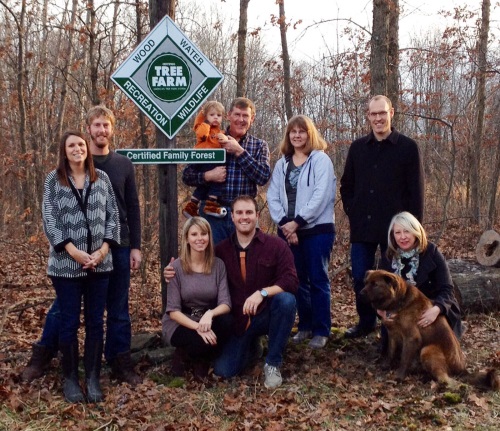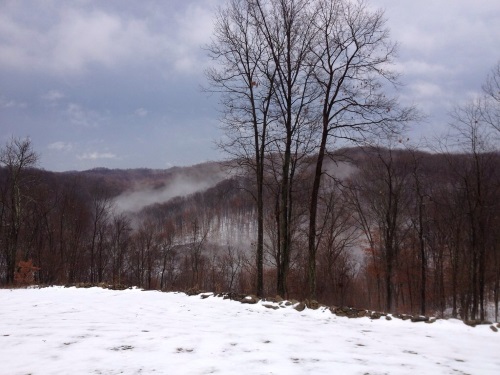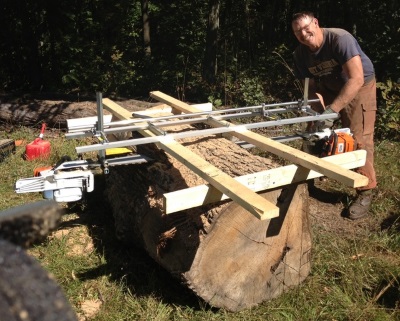The Coldwell Family of Ohio

What makes them outstanding?
The Coldwells intensively manage their tree farm for a combination of timber production and wildlife habitat, offer forestry consulting services, fight for fair forestland tax rates, and market their own salvaged character wood. The scope of the management practices completed on the Coldwell Tree Farm is very impressive with thousands of management hours spent managing hundreds of acres of forestland. The education, community outreach, and advocacy of the Coldwell Tree Farm includes multiple farm tours and field days, hundreds of hours educating both students and the general public, and a lawsuit over taxable valuation of forestland in which the Coldwells prevailed. The Coldwell Tree Farm hates wasting a resource, so they started a business, OhioWoodLands, LLC, to market wind-blown and undesirable trees that would otherwise go to waste. Collectively, these are the reasons the Coldwell Tree Farm stands out.
“Ohio has many active certified tree farms, and the Coldwell Family stands out for their all- around family enthusiasm. The family lives tree farming, and effectively shares their knowledge and experience from applying numerous forestry practices to producing wood products. The family’s openness and zeal for cultivating and improving their woodlands is matched by their hospitality and public promotion of good forestry, quality wildlife, specialty wood, and environmental quality. They have shared their passion well, inspiring many other woodland owners to be active stewards of their properties.” - Robert Boyles, ODNR Deputy Director and Chief, Division of Forestry
Tree Farmer Story
 The Coldwell Tree Farm is
located in southern Columbiana County Ohio and consists of 689 acres with 620
acres of managed woodlands. The farm is owned and managed by Dave & Lisa; Jed,
Emily, Silas & Caroline; Jared, Carly & Kinsley; Josh & Cinda
Coldwell. The tree farm was officially certified with the American Tree Farm
System in 2003 but the Coldwells have managed their woodlands since the mid
1980s. The original parcel of woodland was purchased in 1983 and they continued
to add acreage until the purchase of the last parcel in 2008. In 1988, the
Coldwells contacted James T. Elze, the state service forester at the time for
their county, to have their property put on the Ohio Forest Tax Law program to
reduce the property taxes.
The Coldwell Tree Farm is
located in southern Columbiana County Ohio and consists of 689 acres with 620
acres of managed woodlands. The farm is owned and managed by Dave & Lisa; Jed,
Emily, Silas & Caroline; Jared, Carly & Kinsley; Josh & Cinda
Coldwell. The tree farm was officially certified with the American Tree Farm
System in 2003 but the Coldwells have managed their woodlands since the mid
1980s. The original parcel of woodland was purchased in 1983 and they continued
to add acreage until the purchase of the last parcel in 2008. In 1988, the
Coldwells contacted James T. Elze, the state service forester at the time for
their county, to have their property put on the Ohio Forest Tax Law program to
reduce the property taxes.
Dave Coldwell got started in
marketing timber when a neighbor of his was approached by a lumber company
about selling her timber. Dave was at the neighbor’s property cutting fire wood
at the time and discovered the details of the proposed timber sale. After the
timber buyer left, Dave advised his neighbor that the offer was extremely low
and offered to help with a sale. Dave didn’t know everything about forestry,
but being a tree farmer, he did know most some of basics. After the timber was
marked and bid out, the landowner got 10 times the amount of the first offer
and still had a nice woods remaining. Other friends and neighbors in the
community heard of the successful timber sale and started calling Dave to help
them with their sales. Realizing that he could help out his  neighbors and make
a little supplemental income, Dave founded Coldwell Timber Consulting LLC. As
time went on, Dave thought that maybe one of his sons might want to take over
the consulting business some day. After graduating from Hocking College and The
Ohio State University with a B.S. Degree in Forestry, Jed Coldwell took over
the consulting business in 2005. The Coldwell’s forestry consulting business
has now reached outside of their local community and now serves most of eastern
Ohio.
neighbors and make
a little supplemental income, Dave founded Coldwell Timber Consulting LLC. As
time went on, Dave thought that maybe one of his sons might want to take over
the consulting business some day. After graduating from Hocking College and The
Ohio State University with a B.S. Degree in Forestry, Jed Coldwell took over
the consulting business in 2005. The Coldwell’s forestry consulting business
has now reached outside of their local community and now serves most of eastern
Ohio.
Dave’s youngest son, Jared, was also interested in a forestry-related career. While he was still in college at West Virginia University, he met with two men at a forestry field day who influenced his future. Tree Farmers Dave Hively and Dick Potts started discussing Paul & Kathy Easleys wood salvaging operation in Illinois. The Easleys were selling wood products from what most foresters would call junk or cull trees. The conversation sparked his interested, and upon graduating with a B.S. in Forestry, he made arrangements to meet the Easleys with the idea of starting a similar business. Jared’s new venture, Ohio Woodlands,LLC, was started using lumber salvaged from thinned aspen, soft maple, cherry, and other trees that had started to decompose. The idea was to sell the character of the wood. The rougher the log and wilder the grain, the better. Within a couple years, Ohio Woodlands was a full time business. At least 50% of the character wood sold at Ohio Woodlands’ store is cut from the Coldwell Family Tree Farm. Most of this lumber is from trees that are low grade or cull trees that would normally go to waste.
Approximately 40,000 bf have been harvested in the last 8 years to supply the store. With the recent purchase of a Granberg Alaskan chainsaw mill, custom natural edge wood cuts of up to 60 inches wide can be utilized. The Alaskan mill is really something to see with Stihl 660 power heads on both ends of a 72 inch bar. A local TV station did an interview with Jared about Ohio Woodlands for the Casey Malone Show. The program showed why flame, spalt and burl makes these junk trees desirable to wood workers tired of plain strait grain. The business was also featured in a regional publication - The Farm and Dairy. Jared has sold approximately eight thousand individual, live edge slabs in the last 8 years all over the world to weekend woodworkers, interior designers, and high end furniture makers. His live edge slabs have been sold to all 50 states, the UK, Canada, Australia, Mexico, Singapore, Russia, and China. His complete inventory can be seen at www.ohiowoodlands.com
The Coldwells have invested countless hours fighting for fair taxation of private forestlands in Ohio. Recent changes in the valuation of both farmland and forestland in Ohio have caused property tax bills to triple, creating a huge backlash of upset landowners demanding fair taxation. The state of Ohio utilizes two plans which give a tax break for managing your forest property. OFTL gives 50% reduction and CAUV provides an even greater reduction, based on soil types. In 2004, the Coldwells purchased an additional 98 acres that adjoined the rest of their property, which was already designated under CAUV. The county auditor's office denied their application to have the newly purchased wooded acreage valued under CAUV, which would have given them a significant property tax reduction. The Board of Revision upheld the county auditor's determination when the Coldwell's objected. Upon further research of the Ohio Revised Code dealing directly with CAUV, the Coldwells believed they met the criteria to be accepted into the program and, without delay, took the case to the Court of Common Pleas. The case was the subject of numerous news articles in the Farm and Dairy. In March 2007 Judge C. Ashley Pike ruled in favor of the Coldwells and CAUV valuation was given retroactively to tax year 2005. The Coldwells have proven to be leaders in the battle for fair taxation. Their efforts have had and will have far reaching effects.
Wood
Forest management practices are implemented on the Tree Farm with the goal of maximizing growth rates of desirable hardwoods. In the past 14 years, the Coldwells have completed over 275 acres of grapevine control, 180 acres of various non-commercial thinnings, 75 acres of invasive species (multiflora rose, bush honeysuckle, and autumn olive) control, and 50 acres of tree planting. Wind-blown and undesirable trees of commercial size are often harvested, milled, kiln dried and sold by OhioWoodLands. A commercial timber harvest will take place on a 50 acre portion of the Tree Farm sometime in the near future. Mature and defected trees will be harvested to improve the growth rates of residuals and encourage natural regeneration in the understory.
Water
Between the end of August through the middle of October, 2010, the Cleveland Museum of National History Botany staff and natural areas division staff conducted seven survey days on the Coldwell property. Staff members Dr. James Bissell, Larry Rosche, and Judy Semroc. Listed below are some of their findings.
The state threatened spotted panic grass was collected from 2 sites on the Coldwell property, an upland spring head north of Hull Rd. and west of Nancy Run Valley and the rich rocky woods along the west side of Nancy Run. Springs are present on uplands, valley walls, and rocky slopes on the Coldwell property. Nine species of salamanders were located on the property. Mixed hardwood forest types on the west valley of Nancy Run have an outstanding diversity of species. There is a pond at the base of the slope and a vernal pond is present on the ridge above the slope. The entire slope is covered with rocks ranging from a couple square feet to more than 100 square feet. Seven species of salamanders were located within the rich rocky woods including the vernal pool species - Spotted Salamanders. Only two records of Spotted salamander are known for Col. County and both are prior to 1988. The rich rocky forest also has groundwater springs. Two-lined salamanders are present under rocks at the base of the slope which indicate the ground water springs have perennial flow.
The current continuous forest cover of the Coldwell lands flanking several headwater streams and main channel of Nancy Run are delivering clean, cold water to Yellow Creek, one of the finest quality tributaries to the Ohio River. (Yellow Creek - which empties into the Ohio River approx. 20 miles to the southeast is under consideration as an Ohio Scenic River)
Wildlife
With Dave being retired from the Ohio Division of Wildlife, management of wildlife is an important part of the tree farm. Hunting with permission is allowed for friends, family and neighbors. Specifically deer hunting is closely monitored by the Coldwells since the property is managed under the Quality Deer Management philosophy. This basically entails making sure there is quality habitat, proper population density, and standards on what age and size deer may be taken. In the past couple of years this philosophy has paid off with some very impressive specimens been taken from the tree farm.
Other findings from the Cleveland Museum of Natural History Study include the following:
- Reptiles: 3 species of turtle, 1 turtle species is of concern, 1 species of snake.
- Odanates: 23 total species ID'd, 3 species are county records.
- Butterflies: 36 total species, 8 county records
- Moths: 24 total species, 11 county records
- Trees and Shrubs: 63 total species, 1 species is potentially threatened
- The Coldwell Tree Farm area includes and helps protect various state listed aquatic species that inhabit the Yellow Creek Watershed, including the Eastern Hellbender, Cavespring Crawfish, and Allegheny Crawfish.
- A diversity of habitat allows for a healthy population of resident and migratory songbirds, raptors, and other non-game species.
- A small wetland, the byproduct of pre-law strip mining, is located adjacent to Nancy Run in the Foundry Hill Bottom. Beavers assist in keeping water levels high, and provide much needed habitat for fur bearing animals, waterfowl, and other non-game species such as the Great Blue Herron.
Recreation
On one of the Coldwell’s parcels is a homestead settled in the mid to late 1800’s by Irish immigrants. At the time most of the land, though some was very steep, was cleared for pasture or cultivation. Now the land is almost entirely wooded. Stone walls were constructed enclosing and subdividing about 15 acres and probably retained sheep. One of the more unique features of the old farm was a stone walled corral. The barn, house and spring house foundations are all still visible. The pioneer-developed spring and remnants of a self-flushing latrine is a point of interest. Herbert Brown, age 85, who lived on the property from 1930 to 1938, was able to show the Coldwells where all the old buildings were and explain what they were used for. He even found the rock in front of the barn that they used as a step stool to mount their horses. There are even remnants of a pioneer-developed spring.
Each year, many family members, close friends, and neighbors take advantage of the many recreational opportunities on the Coldwell Tree Farm. Recreation activities include hunting, trapping, berry picking, mushroom hunting, fishing, wildlife viewing, birding, and hiking/camping. Recreational ATV usage is closely monitored to prevent potential damage to the habitat.


